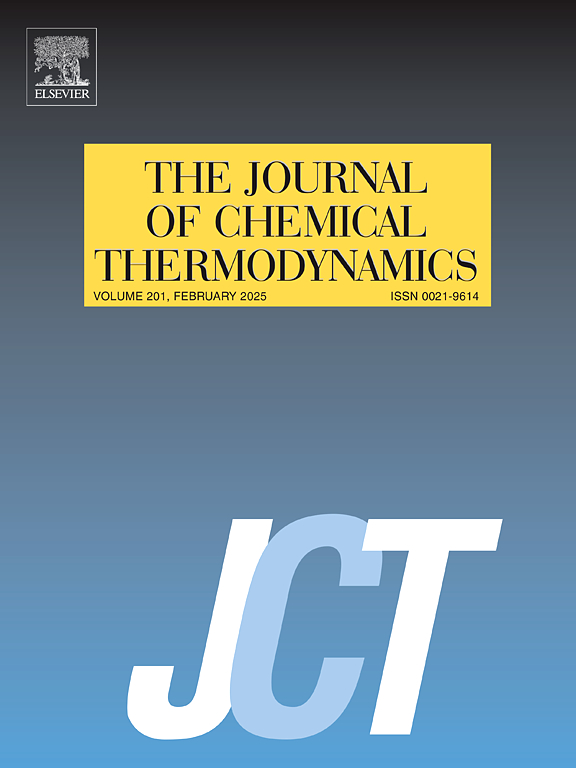磺胺曲酮(形式I)在单、二元溶剂中的溶解度测定、模型评价、分子模拟和热力学分析
IF 2.2
3区 工程技术
Q3 CHEMISTRY, PHYSICAL
引用次数: 0
摘要
采用激光动力学方法,在温度为278.15 ~ 313.15 K、101.6 kPa(标准不确定度高达1.2 kPa)条件下,测定了甲磺曲酮(形式一)在乙醇、正丙醇、正丙醇、正丁醇和二元溶剂(乙醇+水)中的溶解度。采用van't Hoff方程、修正Apelblat方程、λh方程、Wilson模型和修正Jouyban-Acree模型验证了固液平衡数据。修正后的Apelblat方程对磺胺曲酮(表1)的溶解度相关性拟合结果最好。此外,采用Hirshfeld表面分析、分子静电势表面分析、和Hansen溶解度参数,了解甲磺曲酮(Form I)的溶解机理。采用分子动力学模拟分析径向分布函数,探讨甲磺曲酮(Form I)在乙醇+水二元溶剂中的分子间相互作用。最后,利用van't Hoff方程讨论了甲磺曲酮(Form I)在溶剂中的热力学性质,结果表明甲磺曲酮(Form I)的溶解是一个吸热熵驱动的过程。磺胺曲酮(Form I)的溶解度数据和相关热力学分析为磺胺曲酮(Form I)的结晶和纯化提供了基础指导。本文章由计算机程序翻译,如有差异,请以英文原文为准。
Solubility determination, model evaluation, molecular simulation and thermodynamic analysis of sulfentrazone (Form I) in single and binary solvents
The molar fraction solubility of sulfentrazone (Form I) in ethanol, n-propanol, i-propanol, n-butanol, and binary solvents (ethanol + water) was measured by a laser dynamic method at temperatures from 278.15 K to 313.15 K under 101.6 kPa (standard uncertainty is = 1.2 kPa). The solid-liquid phase equilibrium data were verified using five thermodynamic models: van't Hoff equation, modified Apelblat equation, λh equation, Wilson model, and modified Jouyban-Acree model. The modified Apelblat equation showed the best fitting results for the solubility correlation of sulfentrazone (Form I). In addition, the molecular interaction was analyzed using the Hirshfeld surface analysis, molecular electrostatic potential surface analysis, and Hansen solubility parameters to understand the dissolution mechanism of sulfentrazone (Form I). Molecular dynamics simulation was used to analyze the radial distribution function to explore intermolecular interactions of sulfentrazone (Form I) in ethanol + water binary solvents. Finally, the thermodynamic properties of sulfentrazone (Form I) in the studied solvents were also discussed using the van't Hoff equation, and the results implied that the dissolution of sulfentrazone (Form I) was an endothermic and entropy-driven process. The solubility data and the relevant thermodynamic analysis of sulfentrazone (Form I) provide fundamental guidance for the crystallization and purification of sulfentrazone (Form I).
求助全文
通过发布文献求助,成功后即可免费获取论文全文。
去求助
来源期刊

Journal of Chemical Thermodynamics
工程技术-热力学
CiteScore
5.60
自引率
15.40%
发文量
199
审稿时长
79 days
期刊介绍:
The Journal of Chemical Thermodynamics exists primarily for dissemination of significant new knowledge in experimental equilibrium thermodynamics and transport properties of chemical systems. The defining attributes of The Journal are the quality and relevance of the papers published.
The Journal publishes work relating to gases, liquids, solids, polymers, mixtures, solutions and interfaces. Studies on systems with variability, such as biological or bio-based materials, gas hydrates, among others, will also be considered provided these are well characterized and reproducible where possible. Experimental methods should be described in sufficient detail to allow critical assessment of the accuracy claimed.
Authors are encouraged to provide physical or chemical interpretations of the results. Articles can contain modelling sections providing representations of data or molecular insights into the properties or transformations studied. Theoretical papers on chemical thermodynamics using molecular theory or modelling are also considered.
The Journal welcomes review articles in the field of chemical thermodynamics but prospective authors should first consult one of the Editors concerning the suitability of the proposed review.
Contributions of a routine nature or reporting on uncharacterised materials are not accepted.
 求助内容:
求助内容: 应助结果提醒方式:
应助结果提醒方式:


